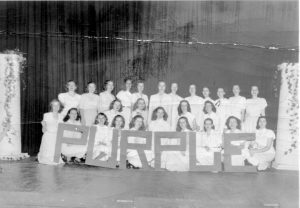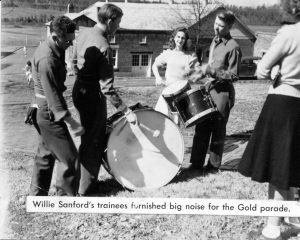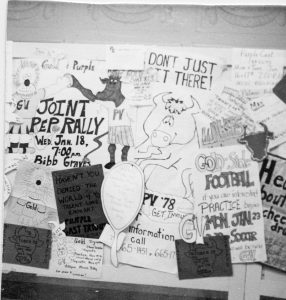In 1919, the young women of the Alabama Girls’ Technical Institute and College for Women held a competition between the Junior and Senior classes. The competition was called College Night, and consisted of stunts, poems, and singing. It did not take long for the tradition to begin evolving. In 1921, only two years after its conception, the two “sides” of College Night—Purple and Gold—were formed to celebrate the school’s 25th anniversary, as a reflection of the school’s colors. For the first time, the sides were pitted against each other, and have remained that way ever since.
In 1930, the performances were held in the newly built Palmer Hall, where they continue to be held today. The 30s proved to be an era of change for the tradition–in 1929, sports were added for the first time (the young ladies played Field Hockey), and the idea of holding the performances Thursday-Saturday was introduced, replacing the original format of the shows being held for a singular night only. It was at this time that an admission charge to see the performances was first charged.
From 1919 until the 1950s, College Night consisted of many small performances. The young women would perform stunts, skits, songs, and poems for the event. Some even did impersonations or gave toasts as their contribution to the side. However, during the 1950s, the idea of having multiple different small performances gave way to a single show, allowing for the students to focus their energies on one project and produce higher quality material. With the introduction of men into the college in 1958, the sports became a scored component rather than just athletic competitions between the two sides, contributing to the overall score of the sides. With the introduction of sports into the scoring, other events such as sign raising and spirit competitions also became scored components.
Prior to 1960, the Production Books were not scored sections. The earliest versions of the books that we have are simple collections of receipts and sheet music, nothing more than a way to track who spent what and give the barest record of what happened during the year. As the tradition continued, the Production Books slowly lengthened—as early as 1943, it was standard to include all the music and scripts of the years’ works, as well as costume and stage designs. This format of receipts and creative works continued until 1960, when the books became scored components with sports, sign raising, and spirit. For the first scored books, the University gave each side an identical binder in which to make their book. After that year, the sides were allowed to make more creative versions of the books, and began the journey to the books of today.
Below is a timeline detailing both the physical and social changes shown through the Production Books.


